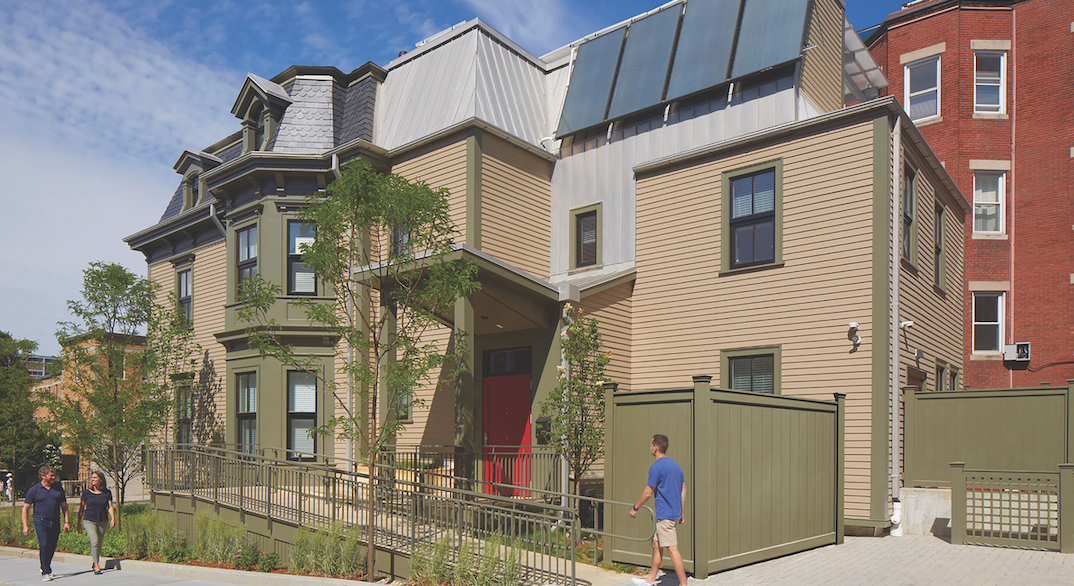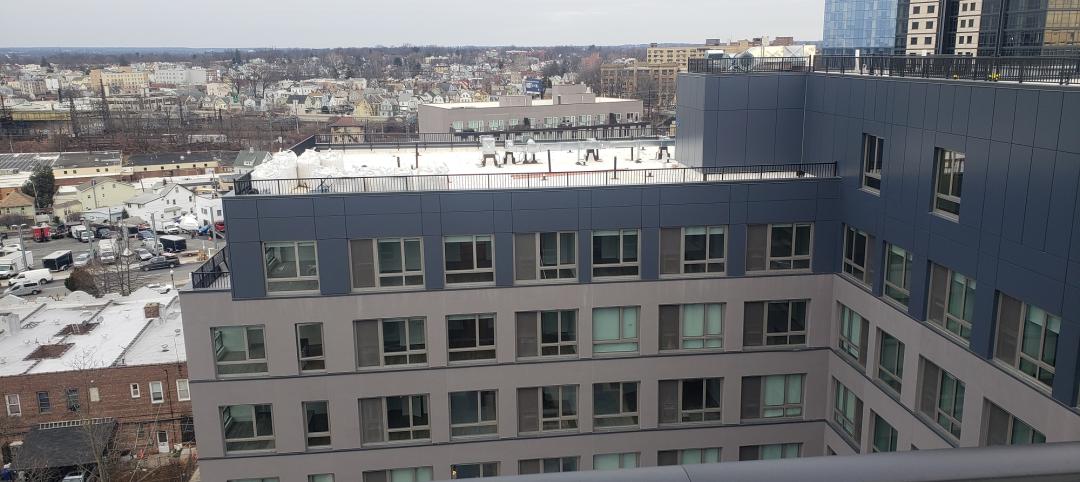Two years ago, Cambridge, Mass., adopted ambitious net-zero energy standards for the construction and renovation of city-owned properties. One of the first projects to fall under this rubric was an 1885 Victorian home at 859 Massachusetts Avenue. The 7,500-sf structure, which was being used as office space, has since been refashioned into a 10-unit shelter for homeless families.
The LEED Gold–certified structure has been operating at “near-net-zero” energy use. Because Cambridge has a strong historic preservation ethos, the project team had to carefully balance energy conservation with the preservation of historical integrity.
The facility replaced a deteriorating structure of similar age and size. “Fortunately, this house was solidly built,” said Lori Cowles, AIA, President of HMFH Architects, the design firm on the project. But its faded aluminum siding, jerry-built front entryway, rusting fire escapes, and paved-over gardens were obvious signs of decline.
The building needed extensive work to be made suitable for modern residential use. The City of Cambridge invested $5 million of city tax dollars in the renovation. “The city believed that the residents deserved a beautiful space,” said Ellen Semonoff, Assistant City Manager, Human Services.
Demolition revealed unexpected structural deficiencies. Floorboards, joists, and sections of flooring were rotted. “The flooring had some hand-hewn boards that were not standard-sized,” said Brendon Roy, Project Manager for the city. “They had to be shimmed or cut down to make them work.” New footings were poured to reinforce the structure. The rubble foundation required extensive patching.
A MAJOR SETBACK, A NEW OPPORTUNITY FOR MULTIFAMILY HOUSING
One of the keys to reaching net zero was to install a geothermal heating/cooling system. But two attempts to drill 900-foot wells on site resulted in nothing but broken drill bits. At this point construction was well under way, so the city decided to drop the geothermal option.
That turned out to be a blessing. The mechanical engineer, Garcia, Galuska & DeSousa, substituted variable refrigerant flow technology with an above-ground air-to-water cooler. “The efficiency on this system turned out to be better than a geothermal well,” said Roy.
A generously insulated, tight envelope was critical to achieving net-zero energy efficiency. The thickness of exterior walls was doubled so that a six-inch layer of continuous mineral wool outboard of the studs could be applied. Four inches of cellulose insulation was blown in between the studs. The interior of the foundation was insulated with 4½ inches of closed-cell spray foam.
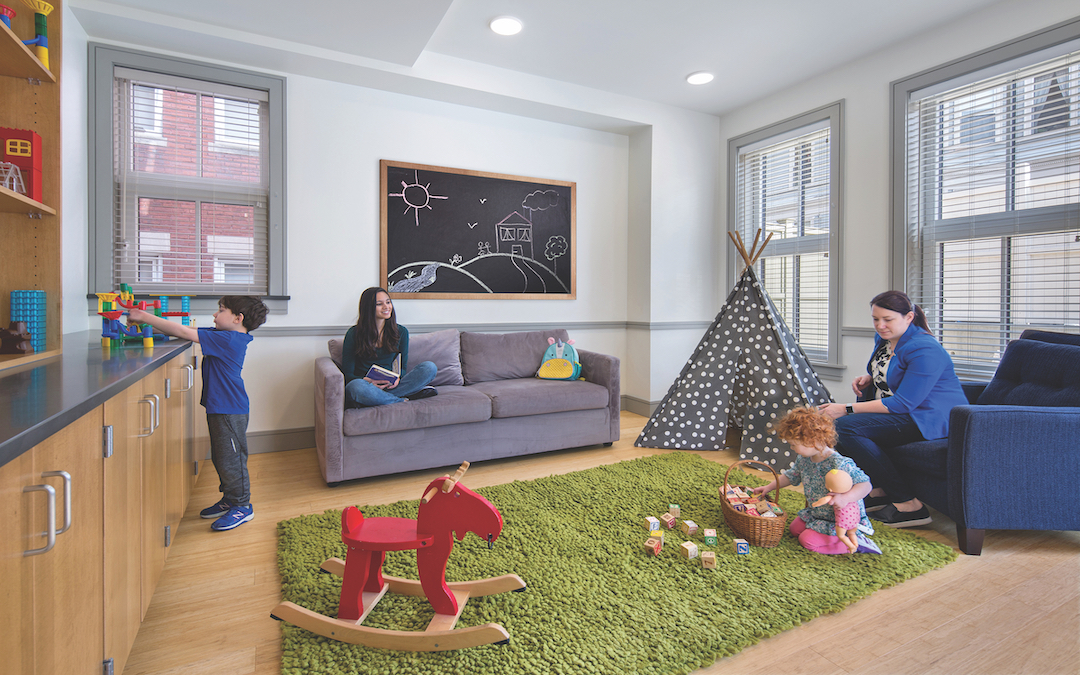 Children share a playroom at Renae’s Place. There’s also a play structure in the backyard. Horizons for Homeless Children hosts a play space weeknights to give parents time to work on job applications and résumés. YWCA Cambridge provides social services and manages the property for the city. Photo: Ed Wonsek
Children share a playroom at Renae’s Place. There’s also a play structure in the backyard. Horizons for Homeless Children hosts a play space weeknights to give parents time to work on job applications and résumés. YWCA Cambridge provides social services and manages the property for the city. Photo: Ed Wonsek
Eight inches of cellulose insulation was blown in between the roof rafters, and five inches of rigid extruded polyisocyanurate was installed under a section of flat roof.
Zola Thermo-Clad doors and windows from Germany, made with aluminum-clad wood and triple-glazed with a low-e coating, yielded an R-7 insulation value. “They are better insulated than any other doors and windows—almost three inches thick,” said Roy. “This was bleeding-edge technology, and because they were sourced from Germany, there were longer lead times. But this was something we needed to do to get to net zero, even if it will take 30 years to pay off.”
Final energy use calculations for the first year were not available at this writing. Based on available data, the structure has a predicted site energy use intensity of 17.02 kBtu/sf/year compared to 59.6 site EUI for a typical multifamily building of this type.
HISTORICAL COMMISSION PROVES FLEXIBLE FOR THIS MULTIFAMILY DEVELOPMENT
The Cambridge Historical Commission, which was involved from the early design stage, was open to accepting less than total historic accuracy in some cases. “Cambridge has a wealth of homes from different time periods,” said Cowles. “This is not a one-of-a-kind for the city.” Even though the imported tilt-turn windows were not historically accurate, the commission acknowledged that their tight-sealing capability was crucial to the success of the net-zero energy scheme.
The commission also approved cellular PVC cornices and trim that looked close enough to the original wood from a distance and would be more durable than wood. After the aluminum siding was removed, new clues were revealed. “We could see ghosts of architectural details,” said Cowles. This shadowing helped in the selection of historically accurate exterior features.
Being true to the original design required extensive detective work. “Many of the buildings on the block from that era were gone,” said Cowles. HMFH designers pored over old photographs of the property to help choose appropriate detail features. “We were lucky that the city’s historical commission keeps good records,” said Cowles.
Built during the late Victorian period, the original structure was not as ornate as those constructed in the high Victorian era, “with all the bells and whistles,” said Cowles. Research showed that bright tones were not available at that time, so a muted tan and green color scheme was chosen.
Putting solar panels on roofs is almost always prohibited in historic building projects, but the project team got lucky. “Due to the shape of the roofline, you can’t see the panels from the street, so we were able to put panels on the roof,” said Cowles. Solar thermal collectors mounted to the roof provide hot water.
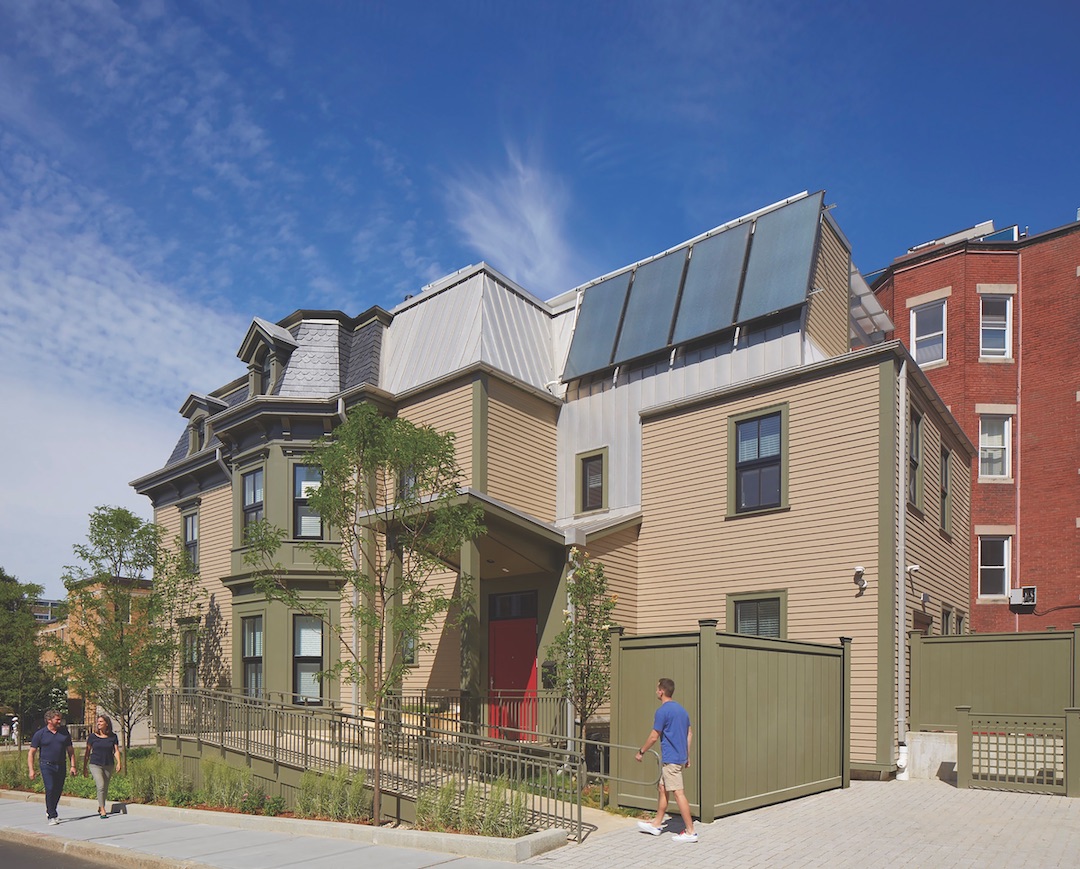 Rather than try to dress up a nonconforming late addition (at right in photo) in Victorian style, designers left it looking pretty much as is and hung photovoltaics at the roof level. PVs on the roof of the original mansion were permitted by the historical commission because they were obscured from street view. Photo: Bruce T. Martin
Rather than try to dress up a nonconforming late addition (at right in photo) in Victorian style, designers left it looking pretty much as is and hung photovoltaics at the roof level. PVs on the roof of the original mansion were permitted by the historical commission because they were obscured from street view. Photo: Bruce T. Martin
The PVs are capable of generating 15.51 KW. But because the local utility does not allow PV systems in this area to export power back to the grid, the property cannot benefit from net metering, and thus does not reap the full benefit of its solar-generating capacity.
The structure probably would have achieved its net-zero goal but for the restriction preventing net metering and the need to put a refrigerator in every unit.
The shelter opened in June 2018. Residents, primarily homeless women and their children, typically spend about 18 months in the facility while they wait for more permanent housing. The upgrades include two units for residents with disabilities.
The units range in size from 220 to 260 sf and can accommodate an adult and one or two children—a tight fit, but better than the alternative. Interiors feature solid surface Caesarstone countertops and LED lighting with sensor technology. There are group kitchens with energy-efficient induction cooktops and dining areas on each floor. Children share a playroom as well as a backyard with a play structure. A private room affords space to case managers from YWCA Cambridge, which manages the building under contract with the city, for confidential meetings with residents about social services.
Aesthetically, the historically reverential restoration is now seen as an asset to the neighborhood instead of a blight. It was named Renae’s Place, for Renae Gray, a longtime activist affiliated with the YWCA. “She died a year before it opened,” said Semonoff. “It embodies her spirit.”
PROJECT TEAM | RENAE’S PLACE
CLIENT City of Cambridge, Mass.
PROPERTY MANAGER YWCA Cambridge
ARCHITECT HMFH Architects
MECHANICAL ENGINEER Garcia, Galuska & DeSousa
GENERAL CONTRACTOR Homer Contracting
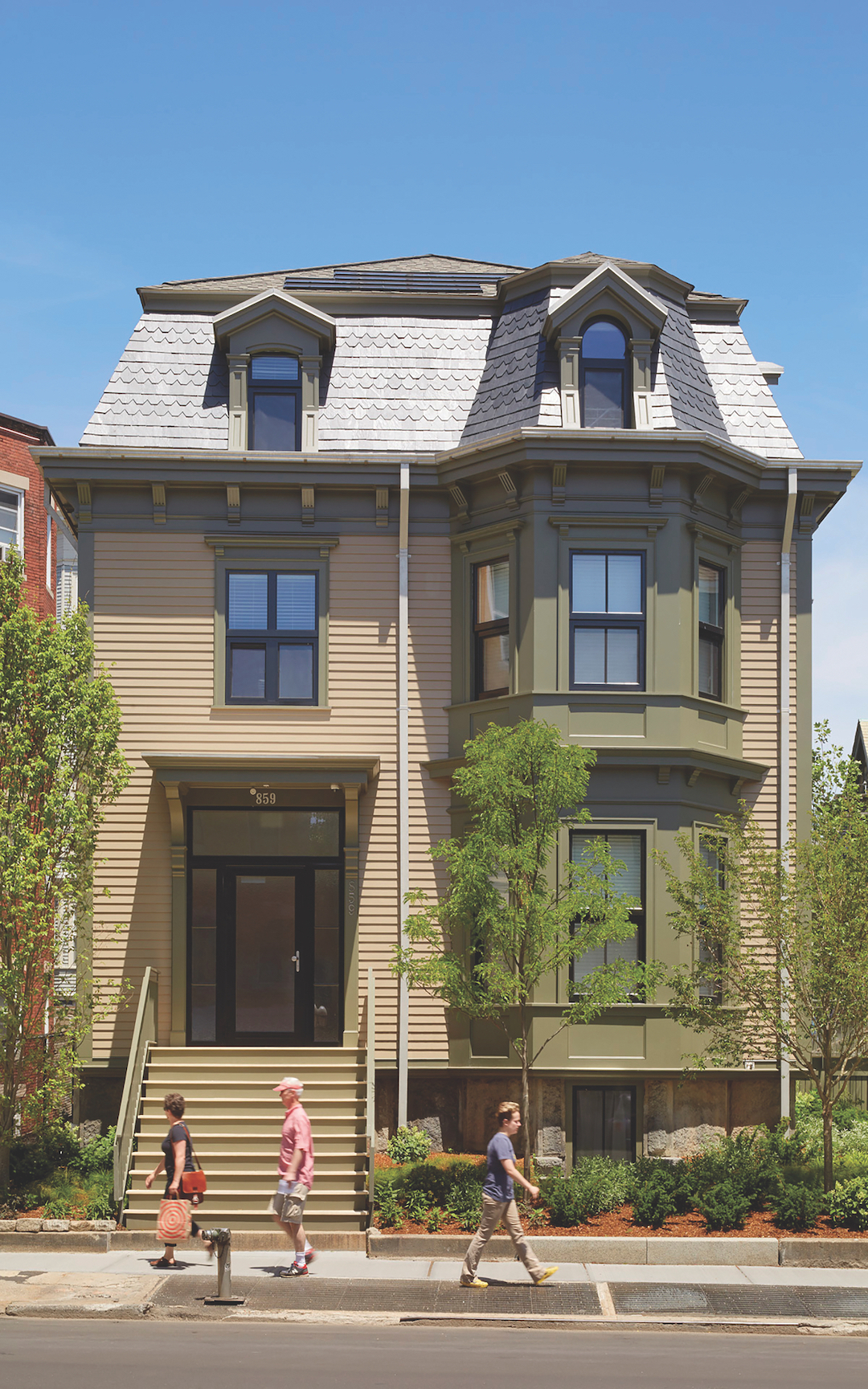 Photo: Bruce T. Martin
Photo: Bruce T. Martin
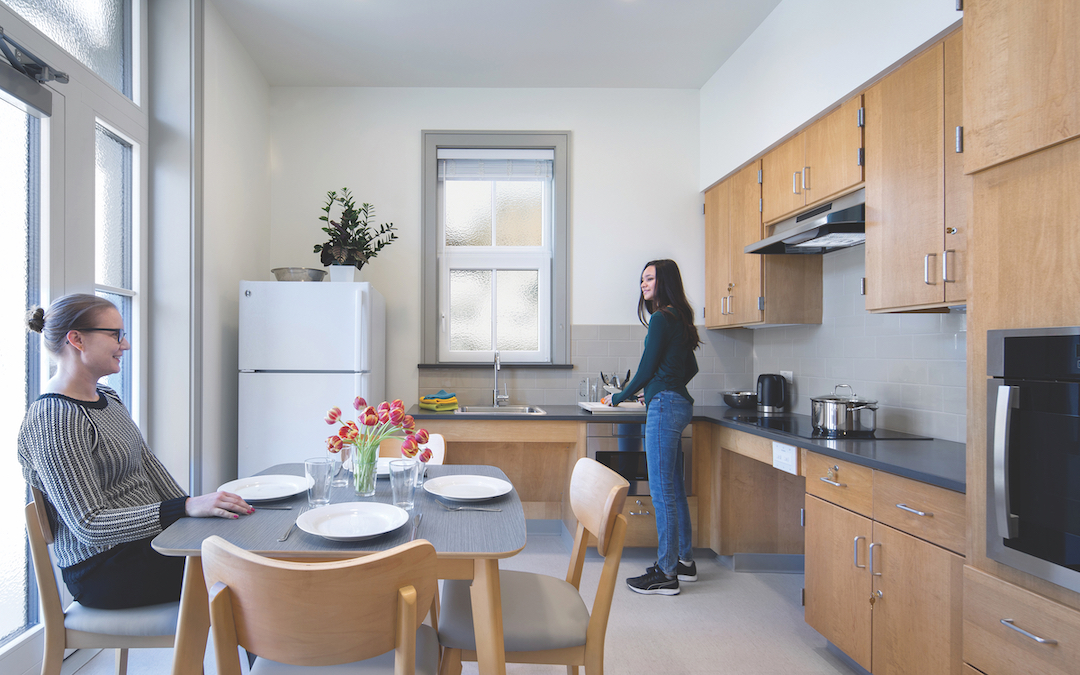 Photo: Ed Wonsek
Photo: Ed Wonsek
Related Stories
Sustainability | Nov 20, 2023
8 strategies for multifamily passive house design projects
Stantec's Brett Lambert, Principal of Architecture and Passive House Certified Consultant, uses the Northland Newton Development project to guide designers with eight tips for designing multifamily passive house projects.
MFPRO+ News | Nov 15, 2023
Average U.S multifamily rents drop $3 to $1,718 in October 2023: Yardi Matrix
Multifamily fundamentals continued to soften and impact rents last month, according to the latest Yardi Matrix National Multifamily Report. The average U.S. asking rent dropped $3 to $1,718 in October, with year-over-year growth moderating to 0.4%, down 40 basis points from September. Occupancy slid to 94.9%, marking the first decline in four months.
Industrial Facilities | Nov 14, 2023
Some AEC firms are plugging into EV charging market
Decentralized electrical distribution is broadening recharger installation to several building types.
MFPRO+ Special Reports | Nov 14, 2023
Register today! Key trends in the multifamily housing market for 2024 - BD+C Live Webinar
Join the BD+C and Multifamily Pro+ editorial team for this live webinar on key trends and innovations in the $110 billion U.S. multifamily housing market. A trio of multifamily design and construction experts will present their latest projects, trends, innovations, and data/research on the three primary multifamily sub-sectors: rental housing, senior living, and student housing.
Multifamily Housing | Nov 9, 2023
Multifamily project completions forecast to slow starting 2026
Yardi Matrix has released its Q4 2023 Multifamily Supply Forecast, emphasizing a short-term spike and plateau of new construction.
MFPRO+ News | Nov 1, 2023
Washington, D.C., Queens, N.Y., lead nation in number of new apartments by zip code
A study of new apartment construction by zip code showed Washington D.C., and the Queens borough of New York City are the hottest multifamily markets since 2018, according to RentCafe.
Adaptive Reuse | Nov 1, 2023
Biden Administration reveals plan to spur more office-to-residential conversions
The Biden Administration recently announced plans to encourage more office buildings to be converted to residential use. The plan includes using federal money to lend to developers for conversion projects and selling government property that is suitable for conversions.
Sponsored | MFPRO+ Course | Oct 30, 2023
For the Multifamily Sector, Product Innovations Boost Design and Construction Success
This course covers emerging trends in exterior design and products/systems selection in the low- and mid-rise market-rate and luxury multifamily rental market. Topics include facade design, cladding material trends, fenestration trends/innovations, indoor/outdoor connection, and rooftop spaces.
MFPRO+ Special Reports | Oct 27, 2023
Download the 2023 Multifamily Annual Report
Welcome to Building Design+Construction and Multifamily Pro+’s first Multifamily Annual Report. This 76-page special report is our first-ever “state of the state” update on the $110 billion multifamily housing construction sector.


